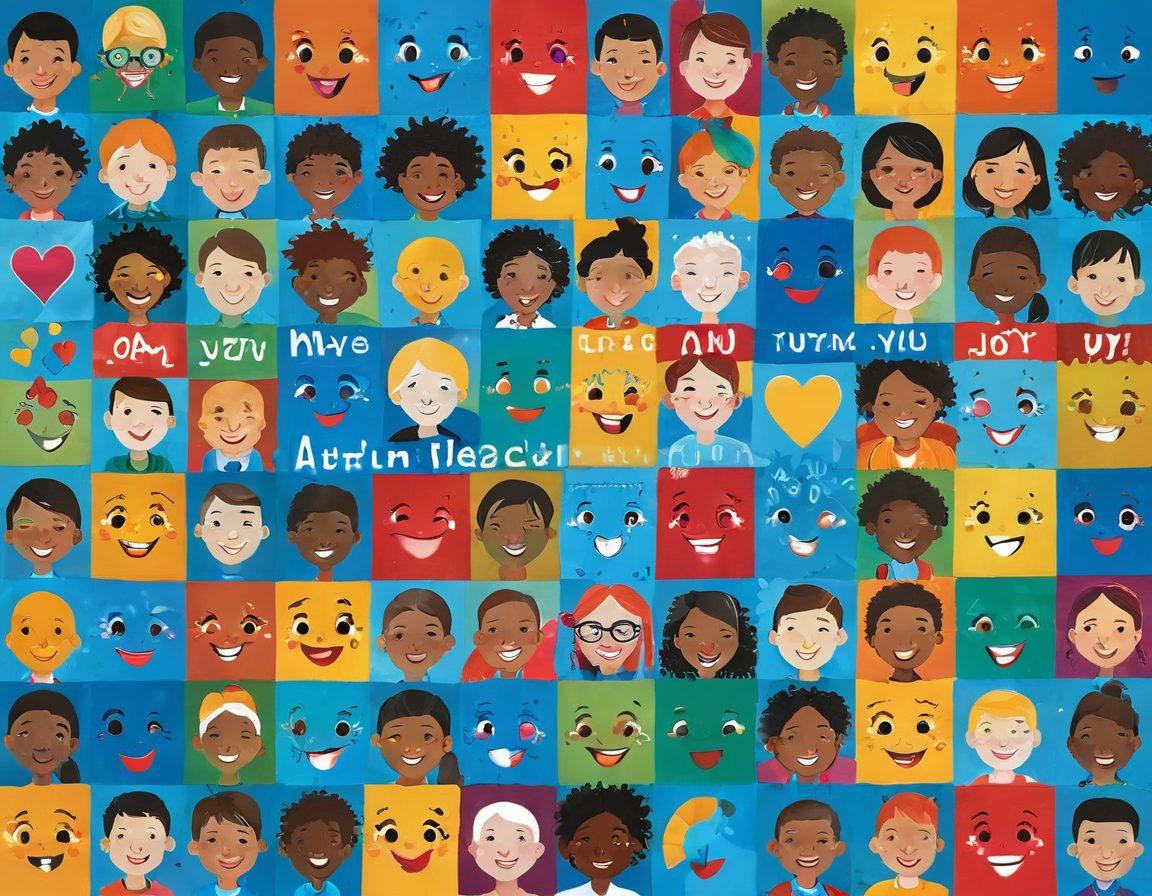Unlocking Joy: The Power of Facial Expressions in Autism Advocacy and Emotional Wellbeing
Imagine walking into a room filled with children, each one radiating a unique warmth through their expressions. This scene embodies the core of autism advocacy, where cultivating happiness through facial expressions creates profound connections. The power of a joyful demeanor can transform interactions, bridging gaps in understanding and offering support for autism that is both heartfelt and effective. As we delve into the dynamics of facial expressions, we uncover a treasure trove of potential for promoting mental wellness and emotional health within the autism community.
Facial expressions are not just a reflection of our mood; they are a universal language that conveys emotions that words sometimes can’t capture. For individuals on the autism spectrum, mastering positive emotions through affectionate interactions can enhance their social skills development and boost self-esteem. By creating environments where happiness flourishes, we equip individuals with the tools to express themselves authentically. It raises an intriguing question: how can we further encourage these joyful connections in our everyday interactions?
The journey of autism advocacy is enriched by fostering a culture of happiness and wellbeing. This includes integrating autism education that emphasizes understanding and interpreting facial expressions. For instance, teaching kids the nuances of a smile or a frown not only aids their communication skills but empowers them to engage more effectively with others. As we share quotes like, 'A smile is the shortest distance between two people,' we remind ourselves of the simple yet profound impact a joyful demeanor can have on emotional connections.
By cultivating happiness through facial expressions, we establish a supportive environment for autism assistance. Such an environment is a breeding ground for positive relationships, resulting in strong networks within the autism community. The more we celebrate emotional health, the more we contribute to a culture that values diversity and inclusion. Here’s a thought: What if every individual could pick up just one tool to enhance emotional fitness? Simply practicing the art of smiling or maintaining eye contact could revolutionize the way they interact with the world.
Engaging with those on the autism spectrum requires patience and understanding. By leaning into the power of facial expressions, we can create openings for joyful communication. Moreover, the ripple effect of such heartfelt connections will not only boost the self-esteem of those we support, but enhance our own mental wellness as well. As we embrace this journey together, let’s commit to nurturing happiness, building confidence, and fostering a community where everyone thrives. The future of autism advocacy lies in our hands—let's harness the beauty of our expressions and make every interaction count!
The Joyful Demeanor: Enhancing Emotional Wellbeing in the Autism Community
In a world that often overlooks the nuances of emotional expression, the autism community shines a light on the beauty of a joyful demeanor. Many may wonder, can a simple change in facial expressions significantly enhance emotional wellbeing? The answer is a resounding yes! As we dive into the profound relationship between facial expressions and joy within the autism community, we discover not just the importance of joy, but how it can lead to improved mental wellness and a deeper understanding of ourselves and others.
Facial expressions serve as the universal language of emotions, transcending barriers and allowing individuals to communicate feelings that words often fail to capture. Imagine the delight of witnessing a genuine smile from a child with autism, a radiant burst of happiness that lights up an entire room. It’s these affectionate interactions that create bridges of connection, offering support for autism while also fostering social skills development. When we encourage positive emotions through joyful expressions, we nurture a culture of openness and acceptance, paving the way for both self-esteem and community cohesion.
The role of autism advocacy in cultivating a joyful demeanor cannot be overstated. Organizations and advocates are tirelessly working to promote an inclusive society where every facet of the autism community is recognized and celebrated. But how can we ensure that joy is embedded in autism education and mental fitness initiatives? By focusing on emotional health and the importance of facial expressions, we can develop programs that encourage expression, understanding, and personal growth. Every smile, every laugh, and every joyful moment can reinforce the idea that happiness is not just attainable but essential for wellbeing.
Moreover, enhancing the joy in the autism community also requires us to be proactive. Have you ever thought about how your own facial expressions impact those around you? By practicing and showcasing a joyful demeanor, we can inspire others to embrace their emotions, encouraging an environment where happiness thrives. Empathy plays a crucial role here; understanding that the ability to express joy is a fundamental part of human experience can empower individuals with autism, enriching their lives and fostering deeper social connections.
As we champion the cause of emotional wellbeing in the autism community, let us remember that joy is not a destination but a journey. Through the incredible power of facial expressions, we can collectively advocate for mental wellness, supporting individuals with autism in their quest for fulfillment and happiness. It is within our grasp to enhance the lives of so many, unlocking the true power of a joyful demeanor and creating a ripple effect of positivity that touches everyone around us. So let’s ask ourselves: How can we be the spark that ignites joy in our interactions today?
Empowering Lives: The Role of Positive Emotions in Autism Support and Education
In a world where connections are essential for happiness, the power of facial expressions becomes truly paramount, particularly within the autism community. Imagine walking into a room filled with children who have different forms of autism; a smile can transform the atmosphere. This simple gesture isn’t just an expression but a gateway to understanding, acceptance, and joy. As we dive deeper into the role of positive emotions in autism support and education, we will uncover how nurturing a joyful demeanor affects emotional health and well-being for individuals with autism.
Have you ever noticed the luminous glow on the face of a child when they experience joy? This is where we begin our journey into exploring the importance of affectionate interactions, especially in autism assistance. Positive emotions aren't merely a source of happiness; they're a vital part of mental fitness and overall mental wellness. For children on the autism spectrum, these expressions can open doors to social skills development, enhancing their self-esteem and ability to connect with those around them.
One heartwarming story comes from an autism support group that focused on emotional health through art. They organized sessions where participants could express themselves not just through words but through different forms of visual expressions. This not only resulted in laughter and joy but led to amazing breakthroughs in their ability to communicate. When a child painted a happy scene, their peers and educators responded with positive expressions, which fostered a powerful feedback loop of joy. Could this be the paradigm shift we need to enhance support for autism?
As we continue to emphasize the significance of positive emotions in autism education, it's crucial to ask ourselves: how can we contribute to a more supportive environment? Simple gestures like encouraging joyful expressions or creating spaces that celebrate happiness can make a tangible difference. When children see their educators and peers exhibiting a joyful demeanor, it reinforces the notion that they belong to a welcoming community. It reminds them that their emotions matter; thus, breaking the cycle of isolation often felt in autism advocacy.
Ultimately, the journey toward enhanced autism support is one that involves each one of us. Whether you are an educator, a parent, or a mentor, embracing positive emotions in your interactions can foster a nurturing atmosphere that promotes emotional health and wellbeing. As we continue to advocate for individuals with autism, let us remember the profound impact a smile can hold. In those moments of laughter and connection, we find the essence of empowerment and the ultimate goal of unlocking joy in the lives we touch. So, let’s make room for happiness and watch as it transforms lives together!


